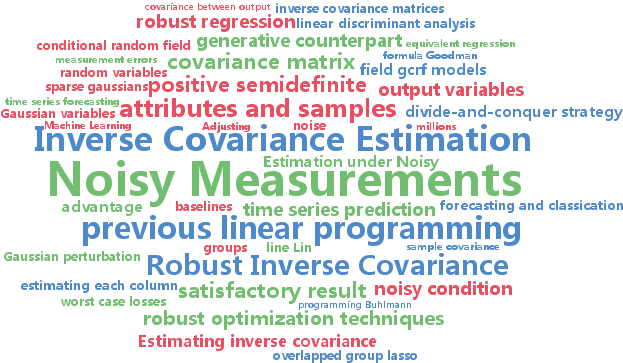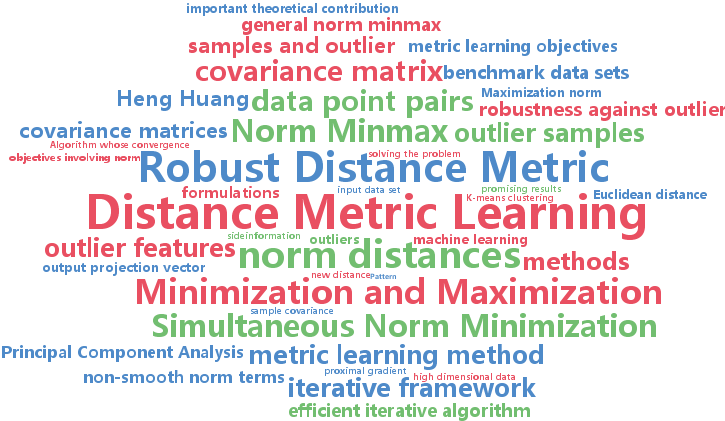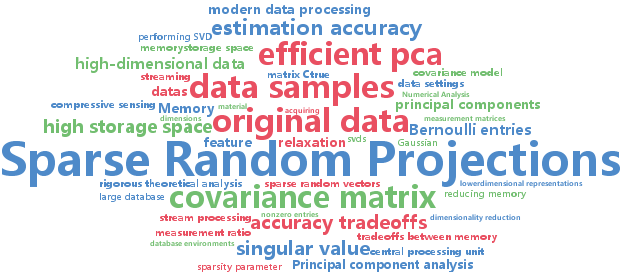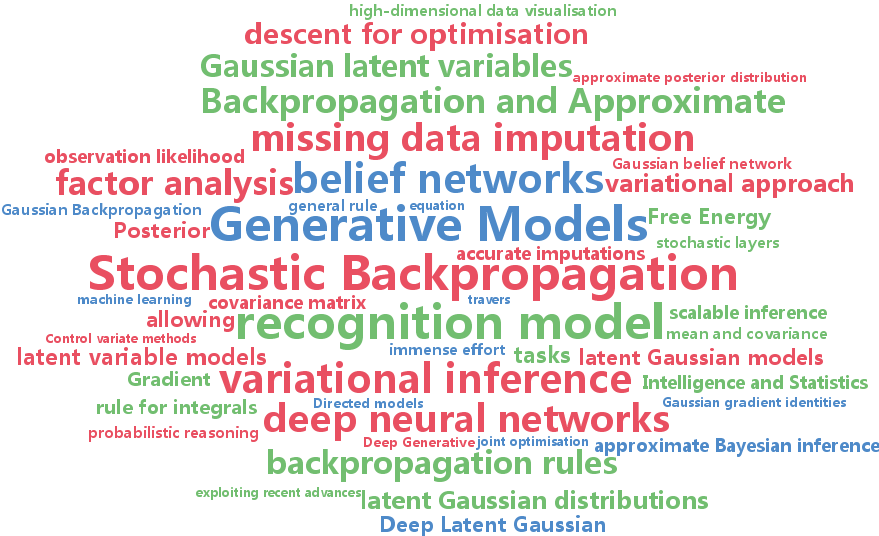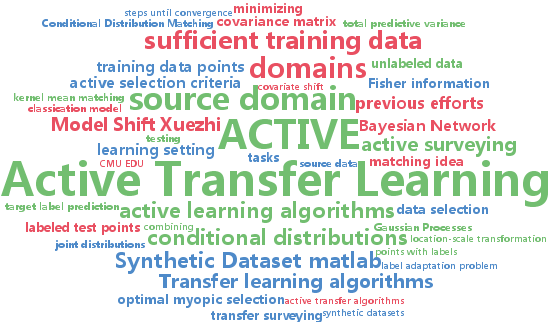covariance matrix
-
Jun-Kun Wang and Shou-de Lin
Robust Inverse Covariance Estimation under Noisy Measurements (pdf)
This paper proposes a robust method to estimate the inverse covariance under noisy measurements. The method is based on the estimation of each column in the inverse covariance matrix independently via robust regression, which enables parallelization. Different from previous linear programming based methods that cannot guarantee a positive semi-definite covariance matrix, our method adjusts the learned matrix to satisfy this condition, which further facilitates the tasks of forecasting future values. Experiments on time series prediction and classification under noisy condition demonstrate the effectiveness of the approach.
-
Hua Wang and Feiping Nie and Heng Huang
Robust Distance Metric Learning via Simultaneous L1-Norm Minimization and Maximization (pdf)
Traditional distance metric learning with side information usually formulates the objectives using the covariance matrices of the data point pairs in the two constraint sets of must-links and cannot-links. Because the covariance matrix computes the sum of the squared L2-norm distances, it is prone to both outlier samples and outlier features. To develop a robust distance metric learning method, in this paper we propose a new objective for distance metric learning using the L1-norm distances. However, the resulted objective is very challenging to solve, because it simultaneously minimizes and maximizes (minmax) a number of non-smooth L1-norm terms. As an important theoretical contribution of this paper, we systematically derive an efficient iterative algorithm to solve the general L1-norm minmax problem, which is rarely studied in literature. We have performed extensive empirical evaluations, where our new distance metric learning method outperforms related state-of-the-art methods in a variety of experimental settings to cluster both noiseless and noisy data.
-
Farhad Pourkamali Anaraki and Shannon Hughes
Memory and Computation Efficient PCA via Very Sparse Random Projections (pdf)
Algorithms that can efficiently recover principal components in very high-dimensional, streaming, and/or distributed data settings have become an important topic in the literature. In this paper, we propose an approach to principal component estimation that utilizes projections onto very sparse random vectors with Bernoulli-generated nonzero entries. Indeed, our approach is simultaneously efficient in memory/storage space, efficient in computation, and produces accurate PC estimates, while also allowing for rigorous theoretical performance analysis. Moreover, one can tune the sparsity of the random vectors deliberately to achieve a desired point on the tradeoffs between memory, computation, and accuracy. We rigorously characterize these tradeoffs and provide statistical performance guarantees. In addition to these very sparse random vectors, our analysis also applies to more general random projections. We present experimental results demonstrating that this approach allows for simultaneously achieving a substantial reduction of the computational complexity and memory/storage space, with little loss in accuracy, particularly for very high-dimensional data.
-
Danilo Jimenez Rezende and Shakir Mohamed and Daan Wierstra
Stochastic Backpropagation and Approximate Inference in Deep Generative Models (pdf)
We marry ideas from deep neural networks and approximate Bayesian inference to derive a generalised class of deep, directed generative models, endowed with a new algorithm for scalable inference and learning. Our algorithm introduces a recognition model to represent an approximate posterior distribution and uses this for optimisation of a variational lower bound. We develop stochastic backpropagation -- rules for gradient backpropagation through stochastic variables -- and derive an algorithm that allows for joint optimisation of the parameters of both the generative and recognition models. We demonstrate on several real-world data sets that by using stochastic backpropagation and variational inference, we obtain models that are able to generate realistic samples of data, allow for accurate imputations of missing data, and provide a useful tool for high-dimensional data visualisation.
-
Xuezhi Wang and Tzu-Kuo Huang and Jeff Schneider
Active Transfer Learning under Model Shift (pdf)
Transfer learning algorithms are used when one has sufficient training data for one supervised learning task (the source task) but only very limited training data for a second task (the target task) that is similar but not identical to the first. These algorithms use varying assumptions about the similarity between the tasks to carry information from the source to the target task. Common assumptions are that only certain specific marginal or conditional distributions have changed while all else remains the same. Alternatively, if one has only the target task, but also has the ability to choose a limited amount of additional training data to collect, then active learning algorithms are used to make choices which will most improve performance on the target task. These algorithms may be combined into active transfer learning, but previous efforts have had to apply the two methods in sequence or use restrictive transfer assumptions. We propose two transfer learning algorithms that allow changes in all marginal and conditional distributions but assume the changes are smooth in order to achieve transfer between the tasks. We then propose an active learning algorithm for the second method that yields a combined active transfer learning algorithm. We demonstrate the algorithms on synthetic functions and a real-world task on estimating the yield of vineyards from images of the grapes.
